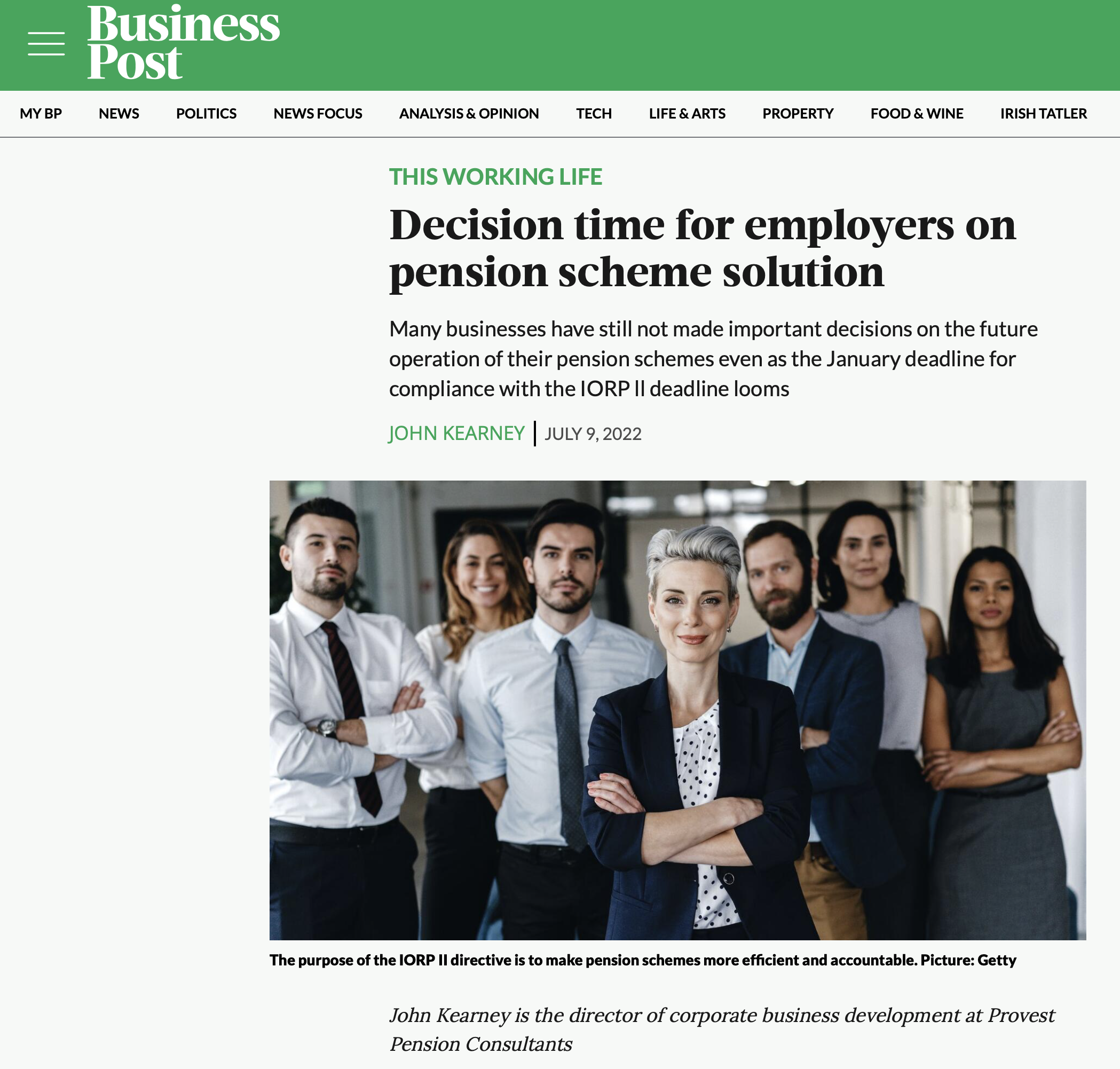Business Post
John Kearney
9th July 2022
Many businesses have still not made important decisions on the future operation of their pension schemes even as the January deadline for compliance with the IORP ll deadline looms
John Kearney is the director of corporate business development at Provest Pension Consultants
The Irish pension landscape will continue to be transformed over the next six months, as employers and trustee boards attempt to achieve full compliance with the IORP II directive before the deadline of January 1, 2023.
April’s transposition of the institutions for occupational retirement provision directive –to use its full name – into Irish law was the most significant change to pensions legislation in more than 30 years.
It imposed significant additional obligations on the trustees of pension schemes, including the directors of companies acting as trustees. And it has fundamentally altered how pension schemes are governed, how risk is managed and how the Pensions Authority, a statutory body, supervises the sector.
Many employers have still not reassessed their pension scheme structure and have not made important strategic decisions on the future operation of their pension scheme. They will need to decide urgently what is the most appropriate solution keeping in mind the January deadline and the capacity challenges that currently exist in the pensions markets across all stakeholders.
The implementation of IORP II will strengthen consumer protection and will also have implications for how the Pensions Authority operates, with a greater emphasis on forward-looking, risk-based supervision. The latter will be more intrusive, more qualitative and more demanding.
Ireland is unique in terms of the number of pension schemes in existence. There were 86,000 defined contribution schemes with active members as of December 31, 2021, according to data provided to the Pensions Authority by regulated entities.
The authority has stated in the past that proper supervision and value for money will not be achieved unless there is a much smaller number of larger, more efficient schemes, and that consolidation of the number of defined contribution schemes is fundamental to improving the Irish pension system.
There is no doubt that the IORP II directive will assist with the consolidation goal of the authority, and it is expected that the number of schemes will reduce to between 150 and 200 by 2027.
The Pensions Authority has also stated that compliance with the directive is not an end in itself. Its purpose is to make schemes more efficient and accountable, and to ensure that there are trustees in place who are able and willing to address the significant responsibilities involved in overseeing and investing pension assets for up to 50 years.
Since the transposition of the directive and the subsequent publication of the Pension Authority’s code of practice for trustees, many employers have reassessed their pension scheme structure.
While some have considered the personal retirement savings accounts (PRSA) option, the proposed changes to PRSAs, including the removal of the certificate of benefit comparison and bringing contribution limits in line with occupational pension schemes, have not materialised. Consequently, the option of transitioning to a master trust has gained more traction in the market.
The Pensions Authority published an employer guide to master trusts and highlighted the importance of selecting a well-run one that offers value for money. Master trusts can be used by several unrelated employers and offer access to economies of scale that may not be the case for all own trust pension schemes.
Additionally, they are future-proofed for future regulatory changes such as the government’s long-awaited auto-enrolment scheme which is scheduled to launch in early 2024, and the potential for in-scheme post retirement drawdowns as highlighted in the 2020 report of the interdepartmental pensions reform and taxation group.
For those employers that have not already done so, they will need to decide urgently what the best solution for their defined contribution scheme is. They can continue their own scheme in its current format, and support the implementation of the IORP II requirements having regard for the enhanced levels of governance and compliance along with the additional cost for the sponsoring employer.
Alternatively, they can consider whether an alternative pension arrangement, such as a master trust, would be a more appropriate and efficient solution. It is imperative that employers and trustees start thinking about this now before it is too late.


